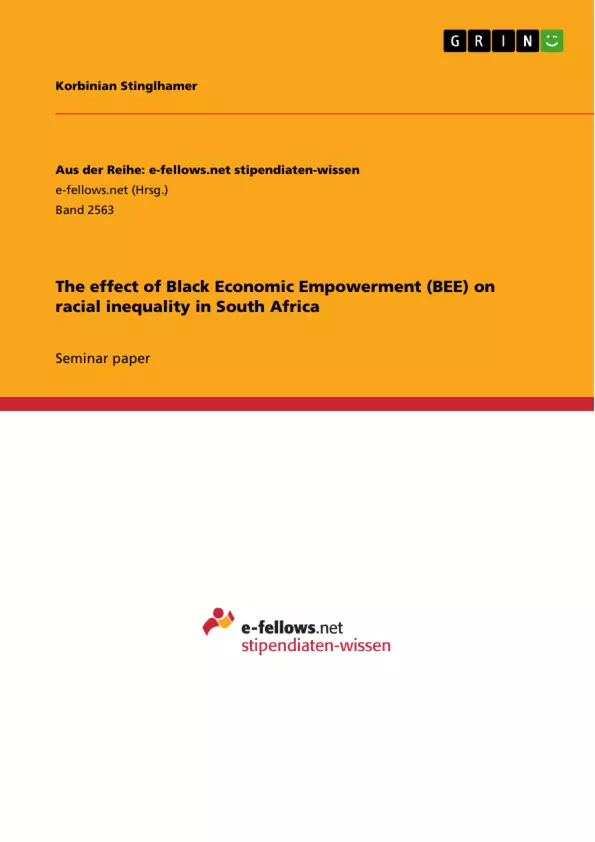This paper investigates the Black Economic Empowerment (BEE) program in South Africa and its economic justification by analyzing the trends in both, intra- and interracial inequality, since the implementation of BEE. Even though inequality is driven by many different factors, this paper attempts to analyze whether BEE was able to effectively reduce inequality in the way that it was intended. My findings suggest that BEE might have helped to reduce inequality between different races, but that it increased inequality among black people.
During Apartheid, black people were excluded from major parts of South Africa’s economy. This resulted in an unequal income distribution in South Africa. Even after Apartheid ended in 1994 income was distributed unequally between races. In order to reduce this inequality and equalize opportunities between the different races in South Africa, the government implemented an affirmative action program called Black Economic Empowerment (BEE) in 2003. In this case and in the following sections, the word “black” defines a racial group, including Africans, coloreds and Indians and can thus be used as synonym for “non-whites.”
BEE introduced a scorecard which rates companies based on their economic inclusion of black people. If the respective company receives a low rating on the scorecard, there will likely be a negative effect on their profit compared to a company with a high rating. The basic critique of BEE is that its main beneficiary is a small elite. Studies about the actual effects of BEE are rare, as data on this topic is limited.
Inhaltsverzeichnis (Table of Contents)
- Introduction
- Background
- Economic inequality before the implementation of BEE.
- Black Economic Empowerment.
- Theory
- Basic labor theory.
- Need for an affirmative action program in South Africa.
- Main findings
- Trends in South African Economy since the implementation of BEE.
- Beneficiary and payers of BEE
- Conclusion
Zielsetzung und Themenschwerpunkte (Objectives and Key Themes)
This paper examines the impact of Black Economic Empowerment (BEE) on racial inequality in South Africa. It aims to analyze the economic justification for BEE and determine its effectiveness in reducing inequality, both between and within racial groups. The paper investigates the trends in economic inequality since the implementation of BEE, focusing on the beneficiaries and payers of the program.
- Impact of BEE on racial inequality in South Africa
- Economic justification for BEE
- Effectiveness of BEE in reducing inequality
- Trends in economic inequality since the implementation of BEE
- Beneficiaries and payers of BEE
Zusammenfassung der Kapitel (Chapter Summaries)
The paper begins by providing an introduction to the concept of Black Economic Empowerment (BEE) and its historical context in South Africa. It highlights the legacy of Apartheid and the need for an affirmative action program to address the persisting economic inequality between different racial groups.
The second chapter delves into the background of economic inequality in South Africa before the implementation of BEE. It examines the extent of income distribution disparities between races during the Apartheid era and the continuation of such disparities after 1994.
Chapter three explores the theoretical framework underlying BEE, drawing on the concept of basic labor theory and the rationale for implementing an affirmative action program in the South African context. This chapter provides theoretical grounding for understanding the intended objectives and potential effects of BEE.
Chapter four presents the main findings of the study, focusing on the trends in South African economy since the implementation of BEE. It analyzes data related to income inequality, employment rates, and other economic indicators to assess the impact of BEE on both interracial and intraracial inequality.
Schlüsselwörter (Keywords)
This paper focuses on the key concepts of Black Economic Empowerment (BEE), racial inequality, affirmative action, economic inclusion, income distribution, and trends in South African economy. The analysis considers both intra- and interracial inequality, examining the impact of BEE on different racial groups and the economic consequences for various stakeholders. The paper utilizes data and research methods to provide insights into the effectiveness and potential limitations of BEE as a policy instrument for addressing racial inequality in South Africa.
- Quote paper
- Korbinian Stinglhamer (Author), 2016, The effect of Black Economic Empowerment (BEE) on racial inequality in South Africa, Munich, GRIN Verlag, https://www.grin.com/document/377206



